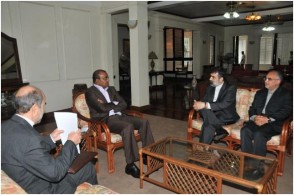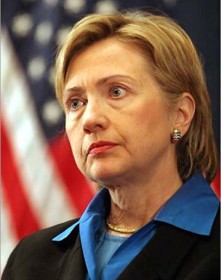Three days after the Obama administration took office, US Secretary of State Hillary Clinton copied a cable to the US Embassy in Georgetown expressing qualms about Iran’s outreach to the Caribbean and seeking clarity on Tehran’s strategic objectives.
The cable dated January 23, 2009 and classified as secret from the freshly sworn-in Secretary of State was dispatched to South American, Caribbean and Central American countries including Guyana. It is one of over 250,000 released by Wikileaks founder Julian Assange and which have created an international uproar. There are said to be 380 cables originating from the US mission in Georgetown. This cable is not one of them.
 In the cable Clinton evinced worry about the ties between Iran and Venezuela and whether these extended to arms smuggling and nuclear cooperation. Clinton’s cable referred to reports that Venezuelan state oil company PDVSA had been linked to arms shipments between Iran and Syria ostensibly for the Lebanon-based militant group Hezbollah. Clinton also asked specifically for information on nuclear cooperation and about Tehran’s connections with other populist governments such as those in Ecuador, Nicaragua and Bolivia.
In the cable Clinton evinced worry about the ties between Iran and Venezuela and whether these extended to arms smuggling and nuclear cooperation. Clinton’s cable referred to reports that Venezuelan state oil company PDVSA had been linked to arms shipments between Iran and Syria ostensibly for the Lebanon-based militant group Hezbollah. Clinton also asked specifically for information on nuclear cooperation and about Tehran’s connections with other populist governments such as those in Ecuador, Nicaragua and Bolivia.
There was no specific mention of Guyana but since the advent of the Obama administration, Guyana’s ties with Iran have grown stronger with President Bharrat Jagdeo visiting Tehran and signing several cooperation deals with Iranian President Mahmoud Ahmadinejad including one for the mapping by Iranian experts of the country’s mineral resources. The latter is seen to be extremely sensitive internationally as Guyana is believed to have significant deposits of uranium and Tehran is actively pursuing the enrichment of uranium for what it says is peaceful purposes while the west strongly suspects that a nuclear weapons programme is in the works. The Guyana deal for the Iranian survey could run afoul of the latest round of sanctions on Tehran as they prohibit third party transactions with Tehran which could enhance its access to uranium. Guyana has not backed away from the deal and an Iranian delegation was recently here.

Deputy Iranian Foreign Minister Behrooz Kamalvandi, met President Bharrat Jagdeo on November 24 this year to continue discussions on fulfilling several of the recent agreements between Guyana and Iran, according to the Government Information Agency.
One agreement is the proposed mapping of mineral reserves. GINA said an initial report on the process was compiled and presented to the Guyanese officials after a visit by a team from the Geological Survey of Iran in March this year. However the Deputy Foreign Minister said the process must be intensified.
“This is one area we are going to follow up to see if there is going to be that possibility here,” the Deputy Foreign Minister told GINA.
The delegation’s visit to Guyana also included a discussion with other counterparts in the Guyana Government such as the Foreign Minister to continue the process of collaboration between the two countries.
“We are supporting each other in international arenas and international organisations. We think that the closer cooperation between our two countries can benefit our two peoples,” Minister Kamalvandi said
The cable
The cable of January 23, 2009 said that Washington analysts assessed that Tehran was reaching out to Latin American countries to reduce its diplomatic isolation and increase ties to leftist countries in the region that Irann perceives may share its anti-US agenda.
“Iran’s ties with Venezuela, which include military cooperation, are the closest and most significant. Given the high-profile Iran-Venezuela relationship, hizballah-linked individuals probably see Venezuela as a safehaven where they can conduct fundraising and support activities without interference. Other populist governments like Bolivia,
Ecuador, and Nicaragua have also sought to create closer political and economic ties with Iran. Iran has established cultural centers in 16 countries of the region and has embassies in 10 countries.”
It then asked for information on a broad range of areas.
“Beyond Iran’s overt policy to increase its diplomatic and economic relations in the region, we lack information on Tehran’s strategic intentions. What does Tehran see as the ultimate goal of Iran’s outreach to Latin America? How high a priority is Latin America for Iranian foreign policy? Does Tehran envision becoming a key regional player in Latin America? Where does Iran think it is in terms of developing relations with the region? What specific countries, groups, and individuals does Iran view as enablers in the region?”

It asked its diplomats whether Tehran had any intention of using the region as a staging ground for potential terrorist attacks by itself or through surrogates – ostensibly the Lebanon-based Hezbollah. It asked if
Tehran and Hezbollah share similar objectives in the region and what, if any, are Tehran’s intentions for strengthening Hezbollah’s objectives in Latin America.
It asked to what extent Tehran and its Latin American allies were cooperating against the US and it also touched on Colombia where the US has a massive anti-drug programme.
“Is Iran supporting terrorist activities in Latin America? Is it responsible for supporting or training illegal armed groups in Colombia or elsewhere?”
The cable also queried whether Iran was using its Latin American ties to circumvent international sanctions and specifically as it relates to weapons development.
“Is there any indication of trade including materials or technology which could be used for weapons development by Iran? This latter question, local analysts say, would currently arise in the context of the Guyana deal with Tehran to map resources.
It also asked about the Islamic state’s cultural and religious ties with the region. “How successful have Tehran’s efforts to exert influence in the region through cultural and religious proselytization been? Are there any indications that these efforts have effectively fostered extremism in Latin America?
What is the religious Shia connection country to country?
Clinton’s cable also transmitted worry over the easing of visa restrictions leading to more Iran traffic in the region.
“Are there any indications that Iranians are taking advantage of Ecuador’s June 2008 decision to lift visa requirements for all visitors traveling to Ecuador for less than 90 days? What steps are Bolivia or others taking to lift their visa requirements for Iran?”
It further asked about Iran’s counter-narcotics efforts in the region, military agreements and the deep ties with Caracas.
“Is there any information indicating PDVSA planes are being used to transport arms from Tehran to Damascus as reported in open sources? Is there any additional information on the Caracas-bound Iranian cargo seized by Turkey? Who or what entity in the Venezuelan military or CAVIM (a Venezuelan military industries company) ordered it and for what purpose? Are Tehran and Caracas actively pursuing any form of nuclear cooperation? And if so, for what purpose? What is the nature of weekly Conviasa flights between Caracas and Tehran? Do we have any information that these are being used for terrorism purposes?”
Clinton’s cable also sought details on financial aid or cash transfers Tehran was providing to Latin American governments and how much aid was delivered as opposed to promised.
It asked specifically about visits by nationals to Iran and about the spread of Shia Islamism. This latter question does have possible connections to Guyana in two contexts. The first is the conviction this year in the US of former PNCR MP Abdul Kadir on a charge of plotting to blow up the JFK Airport in New York. Kadir was seized by US agents in Trinidad while on his way to Tehran. He was flying via Caracas. Kadir had developed close relations with Shia Iran and there were questions about whether the Iranian Government itself was providing aid to his organization. Kadir is to be sentenced in the US.
The other event was the mysterious abduction and murder of a Shia cleric in Georgetown. The body of Mohammad Hassan Ebrahimi, director of Guyana’s International Islamic College for Advanced Studies, was discovered in May, 2004 at the height of a major crime spree. He was seized by gunmen on April 2 in Georgetown as he left the college compound.
The partly decomposed body of the slain academic, with the mouth taped and hands and feet bound was found in a shallow grave in May. The motive for the murder was unclear but there were views that it was more related to regional power politics rather than purely criminal.
Four Iranian police detectives and Iran’s ambassador to Guyana, Ahmad Sobhani, who was based in Venezuela visited to assist local investigators but the murder remains a deep mystery.
Analysts say that many of the questions asked by Clinton in 2009 remain relevant to the region today and in the Guyana situation cooperation on mineral mapping is likely to continue to worry Washington.





